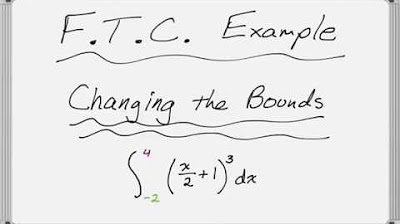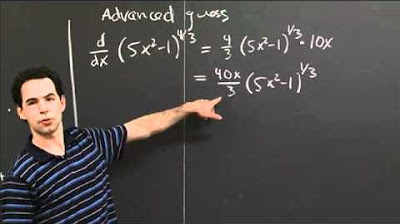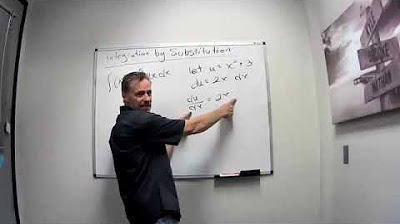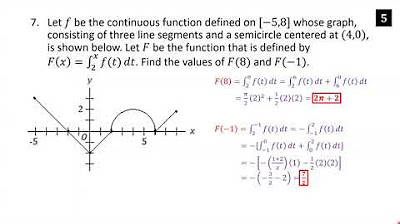Average Value of a Function
TLDRThe video script introduces the concept of using integration to find the average value of a function over a given interval. The presenter demonstrates two methods: direct integration and u-substitution. For the first method, the average value of a function f(x) over the interval from 2 to 5 is calculated using the formula f̄(x) = (1/(b-a)) * ∫[a, b] f(x) dx. The example provided involves integrating the function 3x^2 - 42x + 135, which results in an average value of 27. In the second method, the script covers u-substitution with an example integrating the function 7x^2 * (2x^3 + 13)^(1/2) from 1 to 3. The process simplifies to integrating (7/12) * u^(1/2) du, where u = 2x^3 + 13, leading to an average value of approximately 190.68. The video concludes by noting that homework problems will likely involve similar direct integration and u-substitution techniques.
Takeaways
- 📚 The average value of a function can be found using integration.
- 🔢 The formula for average value is given by \( \bar{f}(x) = \frac{1}{b-a} \int_{a}^{b} f(x) \, dx \).
- 📈 For the first example, the average value is calculated over the interval from 2 to 5.
- 🧮 The integral in the first example is \( \int_{2}^{5} (3x^2 - 42x + 135) \, dx \).
- 🧩 After integrating, the result is evaluated from the upper to the lower limit of the interval.
- 📉 The final average value for the first function is 27.
- 🔑 The second example involves a more complex integral that requires u-substitution.
- 📌 In u-substitution, u is chosen to be the expression within the parentheses of the integrand.
- 📐 The derivative of u is used to solve for dx, which modifies the integral.
- 🧬 The constants can be taken out of the integral, simplifying the expression.
- 🧮 The final average value for the second function, after evaluating the antiderivative at the limits, is approximately 190.68.
- 📚 Students are encouraged to practice similar problems involving direct use of the power rule for integration and u-substitution.
Q & A
What is the formula for finding the average value of a function?
-The formula for the average value of a function f(x) over the interval [a, b] is given by f̄(x) = (1/(b - a)) * ∫[a, b] f(x) dx.
What is the integral expression used to find the average value of the function f(x) = 3x^2 - 42x + 135 over the interval [2, 5]?
-The integral expression is ∫[2, 5] (3x^2 - 42x + 135) dx.
How do you simplify the expression for the average value of the given function over the interval [2, 5]?
-You simplify it by substituting the limits of integration (2 and 5) and the interval length (5 - 2 = 3) into the average value formula, resulting in (1/3) * ∫[2, 5] (3x^2 - 42x + 135) dx.
What is the antiderivative of the function 3x^2 - 42x + 135?
-The antiderivative is (3/3)x^3 - (42/2)x^2 + 135x, which simplifies to x^3 - 21x^2 + 135x.
How do you evaluate the definite integral from 2 to 5 of the function 3x^2 - 42x + 135?
-You evaluate it by finding the antiderivative and then calculating the difference of its values at the upper and lower limits of integration: (Antiderivative at 5) - (Antiderivative at 2).
What is the average value of the function f(x) = 3x^2 - 42x + 135 over the interval [2, 5]?
-The average value is 27, which is obtained after evaluating the definite integral and multiplying by the factor of one-third.
What is the integral expression for the average value of the function involving u-substitution?
-The integral expression is ∫[1, 3] (7x^2 * (2x^3 + 13)^(1/2)) dx, which after u-substitution becomes (7/12) * ∫[1, 3] u^(1/2) du.
How do you choose the substitution u for the second integral problem?
-You choose u to be the expression inside the parentheses that is raised to a power, which in this case is 2x^3 + 13.
What is the derivative of u = 2x^3 + 13 with respect to x?
-The derivative du/dx is 6x^2.
How do you express dx in terms of du after the substitution?
-You express dx as du / (6x^2), which simplifies to dx = du / 6 when x^2 is canceled out from u.
What is the final result for the average value of the function involving u-substitution after evaluating the definite integral?
-The final result is approximately 190.68, obtained by evaluating the antiderivative at the upper and lower limits of integration and applying the average value formula.
What are the key steps in solving an integration problem using the power rule and u-substitution?
-Key steps include setting up the integral with the correct limits, applying the power rule or u-substitution as appropriate, finding the antiderivative, evaluating the antiderivative at the limits of integration, and calculating the difference to find the definite integral.
Outlines
📚 Introduction to Finding the Average Value of a Function
The first paragraph introduces the concept of finding the average value of a function using integration. It presents a specific example where the function f(x) is given, and the goal is to calculate its average value over the interval from 2 to 5. The formula for the average value is provided, which involves dividing the integral of the function from 'a' to 'b' by the interval length (b-a). The example continues with the integration of the function 3x^2 - 42x + 135, and the process includes setting up the integral, performing the integration, and evaluating the result at the bounds of the interval. The final average value obtained is 27.
🧮 Using U-Substitution for Integration
The second paragraph deals with a more complex integration problem that requires u-substitution. The average value of the function, represented as f bar of x, is to be found over the interval from 1 to 3. The function in question is 7x^2 * (2x^3 + 13)^(1/2). The paragraph explains the u-substitution process, where u is chosen as 2x^3 + 13, and the derivative of u with respect to x is used to express dx in terms of du. The integral is then simplified by canceling out the x^2 terms and factoring out constants. The final step involves calculating the definite integral by evaluating the antiderivative at the bounds of the interval, resulting in an approximate average value of 190.68. The paragraph concludes by noting that homework problems will likely follow a similar pattern, involving direct use of the power rule for integration and u-substitution techniques.
Mindmap
Keywords
💡Integration
💡Average Value
💡Function f(x)
💡Interval
💡Formula
💡u-Substitution
💡Derivative
💡Antiderivative
💡Power Rule
💡Evaluate
💡Constants
Highlights
Introduction to using integration to find the average value of a function.
Explanation of the average value formula: f bar of x = 1/(b-a) * ∫[a, b] f(x) dx.
Identification of the interval from 2 to 5 for the function f(x).
Substitution of a and b into the formula to set up the integration problem.
Integration of the function 3x^2 - 42x + 135 over the interval [2, 5].
Integration result includes terms like x^3, -21x^2, and 45x.
Multiplication of the one-third factor through the integrated terms.
Evaluation of the definite integral from 5 to 2.
Final average value calculation results in 27.
Introduction of a second problem involving u-substitution.
Setting up the integration problem for the function 7x^2 * (2x^3 + 13)^(1/2).
Choice of u as 2x^3 + 13 and finding dx in terms of du.
Simplification of the integral by canceling out x^2 terms and constants.
Integration of u^(1/2) resulting in (7/12) * ∫u^(3/2) du.
Substitution of u back into the integral and evaluation from 1 to 3.
Final calculation of the average value which is approximately 190.68.
Emphasis on the direct use of the power rule for integration and u-substitution in homework problems.
Transcripts
Browse More Related Video

Fundamental Theorem of Calculus: Changing the Bounds with u-Substitution

Antidifferentiation by substitution | MIT 18.01SC Single Variable Calculus, Fall 2010

Integration by Substitution

Calculus AB Homework 6.7 U-Substitution

Calculus Divide and Integrate

AP Calculus AB Crash Course Day 8 - Integration and Riemann Sums
5.0 / 5 (0 votes)
Thanks for rating: